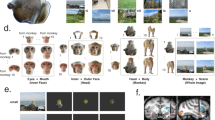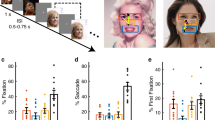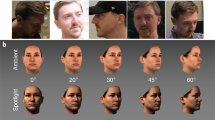Abstract
The rich and immediate perception of a familiar face, including its identity, expression and even intent, is one of the most impressive shared faculties of human and non-human primate brains. Many visually responsive neurons in the inferotemporal cortex of macaque monkeys respond selectively to faces1,2,3,4, sometimes to only one or a few individuals5,6,7, while showing little sensitivity to scale and other details of the retinal image8,9. Here we show that face-responsive neurons in the macaque monkey anterior inferotemporal cortex are tuned to a fundamental dimension of face perception. Using a norm-based caricaturization framework previously developed for human psychophysics10,11,12, we varied the identity information present in photo-realistic human faces13, and found that neurons of the anterior inferotemporal cortex were most often tuned around the average, identity-ambiguous face. These observations are consistent with face-selective responses in this area being shaped by a figural comparison, reflecting structural differences between an incoming face and an internal reference or norm. As such, these findings link the tuning of neurons in the inferotemporal cortex to psychological models of face identity perception.
This is a preview of subscription content, access via your institution
Access options
Subscribe to this journal
Receive 51 print issues and online access
$199.00 per year
only $3.90 per issue
Buy this article
- Purchase on Springer Link
- Instant access to full article PDF
Prices may be subject to local taxes which are calculated during checkout





Similar content being viewed by others
References
Perrett, D. I., Rolls, E. T. & Caan, W. Visual neurones responsive to faces in the monkey temporal cortex. Exp. Brain Res. 47, 329–342 (1982)
Gross, C. G. How inferior temporal cortex became a visual area. Cereb. Cortex 4, 455–469 (1994)
Tsao, D. Y., Freiwald, W. A., Knutsen, T. A., Mandeville, J. B. & Tootell, R. B. Faces and objects in macaque cerebral cortex. Nature Neurosci. 6, 989–995 (2003)
Logothetis, N. K. & Sheinberg, D. L. Visual object recognition. Annu. Rev. Neurosci. 19, 577–621 (1996)
Hasselmo, M. E., Rolls, E. T. & Baylis, G. C. The role of expression and identity in the face-selective responses of neurons in the temporal visual cortex of the monkey. Behav. Brain Res. 32, 203–218 (1989)
Sugase, Y., Yamane, S., Ueno, S. & Kawano, K. Global and fine information coded by single neurons in the temporal visual cortex. Nature 400, 869–873 (1999)
Perrett, D. I. et al. Neurones responsive to faces in the temporal cortex: studies of functional organization, sensitivity to identity and relation to perception. Hum. Neurobiol. 3, 197–208 (1984)
Rolls, E. T. & Baylis, G. C. Size and contrast have only small effects on the responses to faces of neurons in the cortex of the superior temporal sulcus of the monkey. Exp. Brain Res. 65, 38–48 (1986)
Tovee, M. J., Rolls, E. T. & Azzopardi, P. Translation invariance in the responses to faces of single neurons in the temporal visual cortical areas of the alert macaque. J. Neurophysiol. 72, 1049–1060 (1994)
Rhodes, G., Brennan, S. & Carey, S. Identification and ratings of caricatures: implications for mental representations of faces. Cogn. Psychol. 19, 473–497 (1987)
Valentine, T. & Bruce, V. The effects of distinctiveness in recognising and classifying faces. Perception 15, 525–535 (1986)
Leopold, D. A., O'Toole, A. J., Vetter, T. & Blanz, V. Prototype-referenced shape encoding revealed by high-level aftereffects. Nature Neurosci. 4, 89–94 (2001)
Blanz, V. & Vetter, T. in Proc. SIGGRAPH'99 187–194 (ACM, Computer Society Press, 1999)
Lee, K., Byatt, G. & Rhodes, G. Caricature effects, distinctiveness, and identification: testing the face-space framework. Psychol. Sci. 11, 379–385 (2000)
Lewis, M. B. & Johnston, R. A. Understanding caricatures of faces. Q. J. Exp. Psychol. A 51, 321–346 (1998)
Mauro, R. & Kubovy, M. Caricature and face recognition. Mem. Cogn. 20, 433–440 (1992)
Valentine, T. A unified account of the effects of distinctiveness, inversion, and race in face recognition. Q. J. Exp. Psychol. A 43, 161–204 (1991)
Rhodes, G., et al. in Fitting the Mind to the World: Adaptation and Aftereffects in High-Level Vision (eds Clifford, C. W. & Rhodes, G.) 213–240 (Oxford Univ. Press, Oxford, UK, 2005)
Leopold, D. A., Rhodes, G., Mueller, K. M. & Jeffery, L. Dynamics of the face identity aftereffect. Proc. R. Soc. Lond. B 272, 897–904 (2005)
Leopold, D. A. & Bondar, I. in Fitting the Mind to the World: Adaptation and Aftereffects in High-Level Vision (eds Clifford, C. W. G. & Rhodes, G.) 189–212 (Oxford Univ. Press, Oxford, UK, 2005)
Tsao, D. Y., Freiwald, W. A., Tootell, R. B. & Livingstone, M. S. A cortical region consisting entirely of face-selective cells. Science 311, 670–674 (2006)
Sigala, N. & Logothetis, N. K. Visual categorization shapes feature selectivity in the primate temporal cortex. Nature 415, 318–320 (2002)
Baker, C. I., Behrmann, M. & Olson, C. R. Impact of learning on representation of parts and wholes in monkey inferotemporal cortex. Nature Neurosci. 5, 1210–1216 (2002)
Kobatake, E., Wang, G. & Tanaka, K. Effects of shape-discrimination training on the selectivity of inferotemporal cells in adult monkeys. J. Neurophysiol. 80, 324–330 (1998)
Persson, J., Habib, R. & Nyberg, L. Decreased activity in inferotemporal cortex during explicit memory: dissociating priming, novelty detection, and recognition. Neuroreport 13, 2181–2185 (2002)
Kayaert, G., Biederman, I., Op de Beeck, H. P. & Vogels, R. Tuning for shape dimensions in macaque inferior temporal cortex. Eur. J. Neurosci. 22, 212–224 (2005)
Acknowledgements
We are grateful to G. Rhodes, N. Kriegeskorte and N. K. Logothetis for critical comments on the manuscript, and to A. Maier, M. Wilke and K.-M. Mueller for discussions. We especially thank C. Wallraven, B. Knappmeyer and H. H. Bülthoff for conducting experiments aimed at selecting the perceptually most dissimilar faces serving as the stimuli for C99. This work was executed at the Max Planck Institute for Biological Cybernetics, and was supported by a Max Planck Society grant to N. K. Logothetis, as well as grants from the Volkswagen Foundation, DFG and HFSP (to M.A.G.). Author Contributions D.A.L and I.V.B originated the experiment and performed the neurophysiological recordings. All authors performed data analysis and discussed the results. D.A.L. and M.A.G. wrote the paper.
Author information
Authors and Affiliations
Corresponding author
Ethics declarations
Competing interests
Reprints and permissions information is available at npg.nature.com/reprintsandpermissions. The authors declare no competing financial interests.
Supplementary information
Supplementary Notes
This file contains Supplementary Methods, Supplementary Figures 1–11 and legends, Supplementary Tables 1 and 2 and legends, and seven references. (PDF 1075 kb)
Rights and permissions
About this article
Cite this article
Leopold, D., Bondar, I. & Giese, M. Norm-based face encoding by single neurons in the monkey inferotemporal cortex. Nature 442, 572–575 (2006). https://doi.org/10.1038/nature04951
Received:
Accepted:
Published:
Issue Date:
DOI: https://doi.org/10.1038/nature04951
This article is cited by
-
Local features drive identity responses in macaque anterior face patches
Nature Communications (2022)
-
A neuronal social trait space for first impressions in the human amygdala and hippocampus
Molecular Psychiatry (2022)
-
Rapid and dynamic processing of face pareidolia in the human brain
Nature Communications (2020)
-
Convergent evolution of face spaces across human face-selective neuronal groups and deep convolutional networks
Nature Communications (2019)
-
Modelling face memory reveals task-generalizable representations
Nature Human Behaviour (2019)
Comments
By submitting a comment you agree to abide by our Terms and Community Guidelines. If you find something abusive or that does not comply with our terms or guidelines please flag it as inappropriate.



